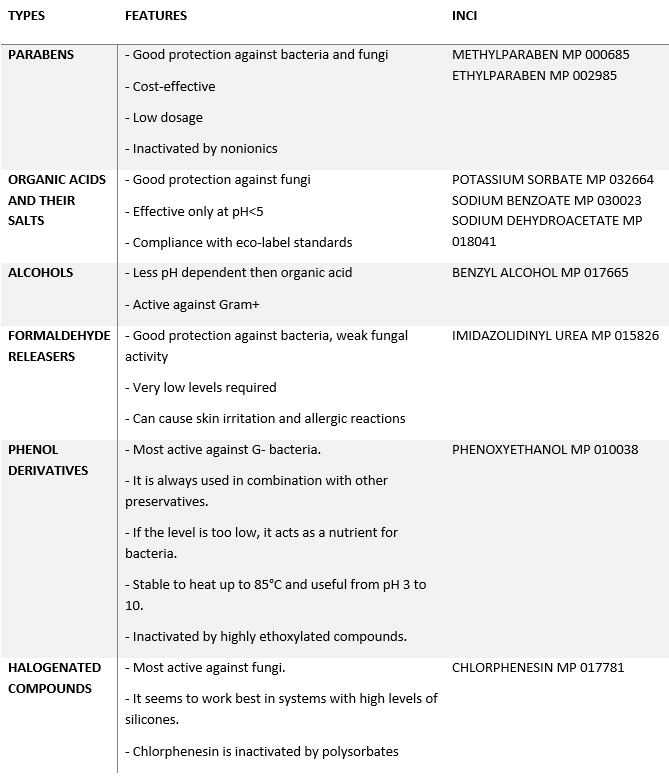Cosmetics, like any product containing water and organic/inorganic compounds, require preservation against microbial contamination to guarantee consumer’s safety and to increase their shelf-life.
Natural products rich in bioavailable nutrients, tend to be more prone to microbe growth than conventional ones.
The most common strategy is based on the application of antimicrobial agents, either by using synthetic or natural compounds or even multifunctional ingredients.

The ideal preservative does not exist and, as a formulator, you must do deep research and trials to find the right combination for product and consumer. The time to preserve all kinds of products with a blend of phenoxyethanol and parabens is over, and the preservative selection should be based on several criteria:
- Spectrum activity: the ideal preservative should be able to kill all types of microorganisms that are yeasts, molds, Gram-positive and Gram-negative bacteria. But in general, chemicals active against bacteria are not active against yeasts and molds, and vice versa.
- Compatibility with the other ingredients of the cosmetic formulation: some ingredients could lower the antimicrobial activity (ex. thiazolinones are inactivated by bisulfites and secondary amines).
- Effectiveness at low concentrations: lower concentrations reduce the chances of irritation or other toxicity concerns. If 0.8% phenoxyethanol is not effective, don’t increase to 1%, try with a different preservative.
- Company and product philosophy: companies can blacklist some raw materials for marketing purposes, but consumer’s safety must guide the choice.
- Solubility: as microorganisms grow in the water phase, the more water-soluble and the less oil-soluble the preservative is, the better it will function.
- pH of the finished product: make sur you consider a potential pH drift of ±10% over the shelf life. A slight increase in pH could dramatically decrease the activity of antimicrobials. The activity of benzoic acid is 94% at pH 3, only 1.5% at pH 6! With organic acids, to decrease the pH instead to improve the quantity of acid could be the solution.
- Cost: it should always be secondary. The cost of a recall and the damage to a company’s reputation is too high a price to pay for an inexpensive preservative that fails.
- Regulatory: preservatives must be allowed in the countries where the product is sold and used within any restrictions of use.

Traditional Preservatives
Types | Features | INCI example |
PARABENS | Good protection against bacteria and fungi Cost-effective Low dosage Inactivated by nonionics | |
ORGANIC ACIDS AND THEIR SALTS | Good protection against fungi Effective only at pH<5 Compliance with eco-label standards | |
ALCOHOLS | Less pH dependent then organic acid Active against Gram+ | |
FORMALDEHYDE RELEASERS | Good protection against bacteria, weak fungal activity Very low levels required Can cause skin irritation and allergic reactions | |
PHENOL DERIVATIVES | Most active against G- bacteria It is always used in combination with other preservatives If the level is too low, it acts as a nutrient for bacteria Stable to heat up to 85°C and useful from pH 3 to 10 Inactivated by highly ethoxylated compounds | |
HALOGENATED COMPOUNDS | Most active against fungi It seems to work best in systems with high levels of silicones. Chlorphenesin is inactivated by polysorbates |
GREEN ALTERNATIVES FOR COSMETIC PRESERVATION

There is a trend to have formulation preservative strategies that stay away from using traditional preservatives. We’ll look at some natural preservation options below:
- Hurdle technology – The idea is to combine materials and factors that inhibit microbial growth. Some of the factors involved in hurdle technology include low pH, low water activity, chelating agents (EDTA MP 018671, phytic acid), airtight packaging (airless, aerosol).
- PRESERVATIVE BOOSTERS – can help disrupt growth by interfering with the microbial cell membranes. The most common are: ETHYLHEXYGLYCERIN, CAPRYLYL GLYCOL MP 028248, GLUCONOLACTONE MP 033456, PROPANEDIOL MP 024636. Other fragrance components have some preservative boosting activity: LEVULINIC ACID GA 180282, p-ANISIC ACID.
- NATURAL INGREDIENTS that have some antimicrobial functionality: TEA TREE OIL MP 032151, ROSEMARY EXTRACT.
- NEW FROM ECSA: INDIGUARD-N is a natural originated antimicrobial for cosmetics that combines extracts of Gallnut, Terminalia Chebula Fruit, Dendrobium Nobile, and Chinese pepper.
Admittedly, preserving products using only natural ingredients is difficult. Be sure to test your preservative system with a challenge test before and after stability.
ECSA Chemicals offers a wide range of effective preservatives that optimally protect your cosmetic products and meet current technical requirements and market trends.
Contact us for further information and tips
